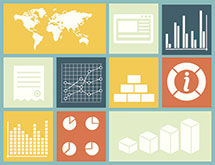Dashboard Delivery

In an industry where efficiency and attention to detail rule, successful supply chain companies have become increasingly sophisticated about ways in which to leverage data to make better-informed business decisions, streamline their logistics and improve their operational performance.
But, with the immense amount of (increasingly granular) data available for supply chain companies to work with, identifying, understanding and utilizing essential information becomes more of a challenge. More information leads to more complexity. In such a data-rich environment, the difficulty is separating the signal from the noise. Increasingly, new technologies are being used to successfully leverage data and transform raw information into meaningful insights.
For many, dashboard solutions provide the ideal combination of flexibility, transparency and power to simplify complexity and provide a clear and comprehensive operational overview. Dashboard technology not only illustrates visually appealing and easy-to-read data, it also makes it possible for supply chain companies to easily identify where and when problems occur, to improve the clarity of data, to increase efficiency, and to allow executives to drill down into specific data sets to gain a more detailed understanding of metrics and measurable results – ultimately leading to improved decision-making capabilities.
In that context, supply chain decision-makers should make it a priority to ensure that they understand the power and potential of an effective dashboard solution, and are familiar with the best practices associated with vetting and implementing such a solution.
The Dashboard Difference
A dashboard is essentially a visual display. The best dashboards provide a clear and comprehensive view of multiple streams of critical information – all in a single place and all in real-time. With a dashboard, essential data from a wide variety of sources can be monitored in one place, with a single screen acting like a window into the heart of a large and complex organization.
The best dashboards are visually appealing, effective and engaging. Dynamic displays of critical information provide unmatched accessibility and transparency – all through an intuitive interface that is easy to use and understand. The real value of dashboards stems from bridging the gap between information and meaning: contributing the requisite clarity, context and continuity to make intelligence actionable.
High quality dashboard solutions can also be programmed to automatically key in on specific variables to identify relationships between events and information that might not otherwise be obvious. These connections can be important in making strategic business decisions. Because decision-makers can access data in real time, progress toward objectives and predetermined metrics can be monitored and evaluated.
Supply chain professionals are aware of the details involved in maintaining an efficient and effective supply chain – as well as the costs and consequences of failing. With a premium placed on minimizing wasted resources and maintaining tight timelines, the ability to track critical information is especially valuable. Dashboards can present a detailed breakdown of logistical, financial and operational dynamics, and can simplify complexities into clear patterns.
Best Practices
While the right dashboard solution can make a defining difference in monitoring and optimizing supply chain logistics, industry decision-makers should be familiar with the best practices involved in system selection implementation.
The metric system
A dashboard is only as powerful as the information it has access to. Consequently, the first step toward making a dashboard solution work for you is to ascertain the specific metrics that impact your organization and should be included in your dashboard. Make a point to pull in essential information and focus in on the critical metrics that drive your operation.
Personnel and priorities
The second piece of the puzzle is to determine who can access the information presented through your dashboard. One of the appealing aspects of a high quality dashboard solution is the flexibility to design one portal for certain personnel and another for others. Executives and high-level decision-makers will likely be more interested in big-picture metrics, while operational professionals and those on the ground will almost certainly benefit from a more practical and tactical set of information.
Presentation and clarity
Another priority should be to conceive and deploy a set of metrics and information that are both sufficiently detailed and easily understood. While it is a mistake to sacrifice nuance and detail for simplistic presentation, straightforward data and clearly comprehensible visuals are important. The best analytics tools should be valuable to more than just specialists and trained data analysts. Executives and management personnel at all levels should be able to understand a dashboard with a single glance – and should subsequently be able to use that information to make timely and informed strategic decisions.
Flexibility and customization
The most effective dashboard solutions are the most flexible. They can be completely customized for the needs and variables of a company. While generic options are available, they tend to lack the complexity and personalization that distinguishes the best solutions. Ensure that the dashboard solution you select is capable of connecting to and integrating with all of your data sources, and that it presents you with a sufficiently dynamic range of customizable options to allow you to visualize the data you need to see in the manner you wish to see it.
In a landscape where organizations are striving to do more with less, leveraging dashboard technology can provide insight that enriches decision-making capabilities leading to enhanced efficiency and an improved bottom line.